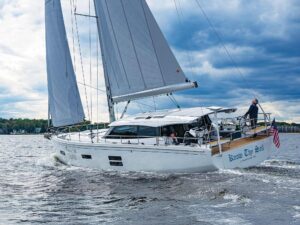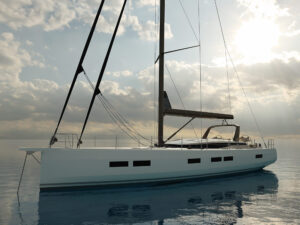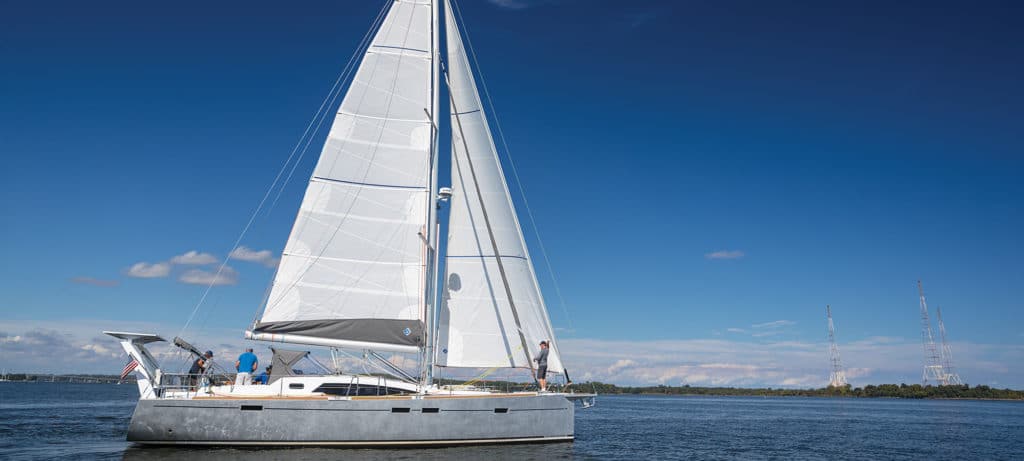
There’s something very French about no-nonsense aluminum cruising boats, perhaps because the vast majority of them are built in France. The very best examples are rugged yet refined, handsome yet utilitarian, and are equally at home either crossing the open ocean or tucked into a secluded cove. When you come across a bare brushed-aluminum hull in a distant anchorage, you just sense that the sailors on board will have an adventurous tale to tell.
At least that’s my impression. And when I first inspected the new Allures 45.9 at last fall’s U.S. Sailboat Show in Annapolis, Maryland — yet another offering with a decidedly French pedigree, starting with its prolific Gallic designer, Olivier Racoupeau — nothing about the yacht’s purposeful lines or inviting interior dissuaded me from that opinion. For long-range cruising, inside and out, the Allures represents the best of two worlds. It really fits my definition of a bluewater cruiser.
With an extended bowsprit forward (for flying off-wind sails and housing the ground tackle, which consists of an optional self-launching Rocna anchor) and a nifty arch aft (perfect for antennas, a wind generator and solar panels, while doubling as dinghy davits), the Allures 45.9 is clean and functional at both ends. In between, there’s no lack of spiffy features and attention to detail.
Working from the bow aft, the double-spreader deck-stepped mast features a Solent rig with a pair of headsails, both on furlers. A copious sail locker is fitted with a crash bulkhead. The faux-teak deck is a product called Marinedeck, a good-looking cork-and-resin composite that doubles as excellent nonskid. There’s a solid vang on the boom that also features a Walder boom brake, which tames the spar when jibing. A pair of safety rails at the mast are properly sized and spaced, and provide plenty of support when working forward. The traveler is stationed on deck just forward of the generous dodger.
The cockpit is very cool. The companionway includes a two-piece acrylic slat that disappears into the deck when not in use. The color-coded vang, mainsheet and reefing lines are led to a suite of winches and clutches to port and starboard on the coachroof. The port locker also houses an opening hatch to the technical room down below; aft of the starboard locker is a nifty nook for stowing the dinghy outboard. The twin helms, affixed to a pair of rudders, are within easy reach of a pedestal just forward of the wheels that control the headsail sheets via a set of Lewmar winches. The walk-through transom leads to a built-in swimming/boarding platform. The underbody of the boat we inspected had the standard skeg/centerboard configuration, though a ballasted swing keel is also an option.
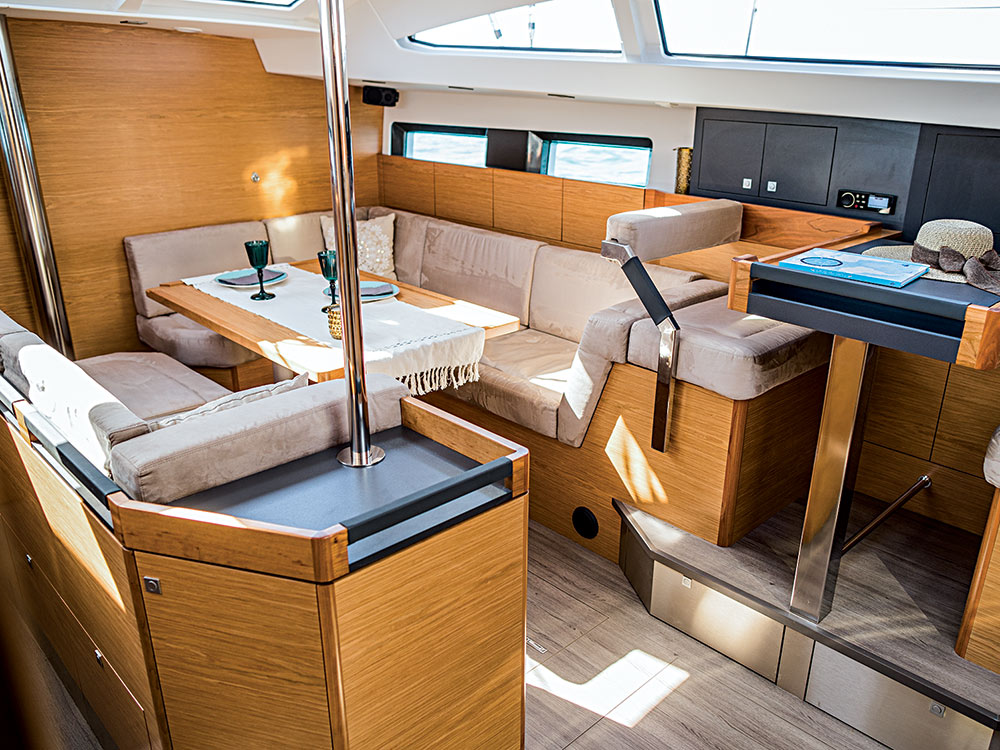
Down below, there are three accommodations layouts from which to choose (basically, you can go with two or three cabins, and one or two heads). Our test boat was a two-cabin model with a large single head to port of the companionway. Aft of the head was the aforementioned technical room (you could also opt for bunk beds instead), which was really terrific. It’s a place to work and store tools that are going to get oily and messy while separating them from the other living spaces. The generator also lives there, and there’s even room for a washing machine should you so desire.
Stepping down below, you are greeted by an interior layout that belies the workmanlike appearance of the robust topside. In other words, it doesn’t look like an expedition boat but rather a contemporary cruising boat with accouterments that wouldn’t feel out of place on a modern, French production model from builders such as Beneteau, Jeanneau or Dufour.
In the main saloon, to port is the straight-line galley; the back of a long, amidships settee provides support for the cook when working at sea. To starboard is a raised navigation station (something you see less and less of on new boats) with seats both fore and aft of it. A large L-shaped settee is forward of the nav table, with a drop-down table that allows for a giant double berth in its lowered position. All three versions include a luxurious forward stateroom, with or without an adjacent head.
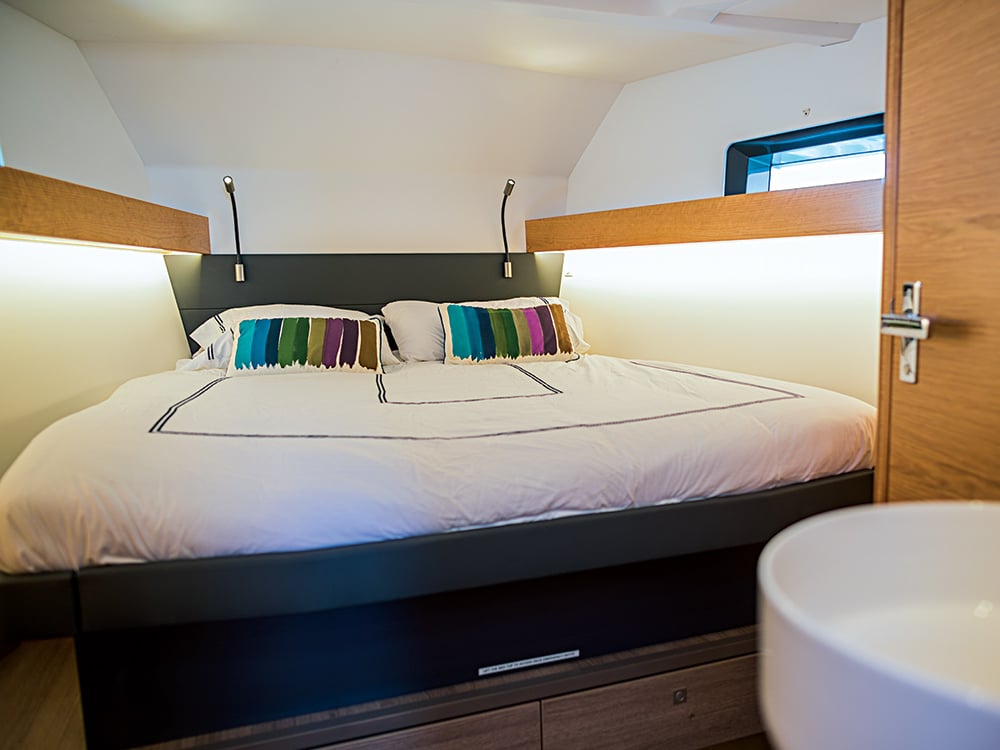
The construction of the Allures 45.9 is straightforward: The hull and transom are welded aluminum, while the deck and coachroof are fiberglass with a foam core. Down below, for sound and weather insulation, the hull is insulated foam with neoprene.
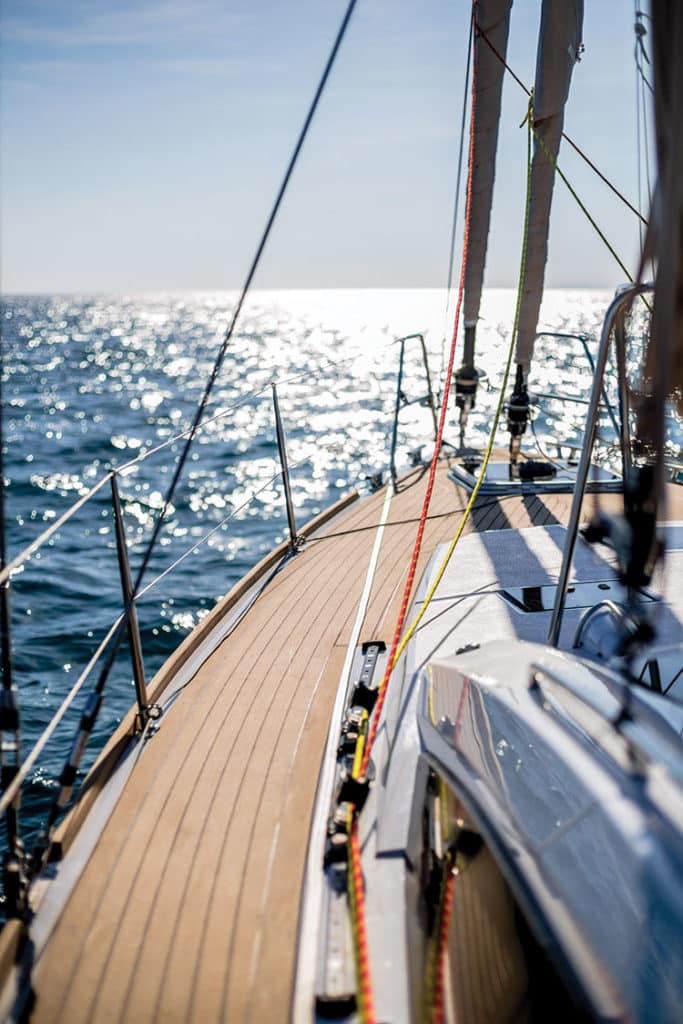
We sailed the boat in rather disappointing conditions on Chesapeake Bay, with winds that hovered in the 5-knot range. Surprisingly, even in the light airs, the Allures ghosted along at better than 3 knots. The centerboard is a neat feature because it provides a bite to windward when lowered but can also be raised when reaching or running off the breeze. And, of course, it allows access to shallow anchorages that are out of bounds to other boats of this size.
The Allures 45.9 is imported into the U.S. market through a sole distributor, Swiftsure Yachts, based in Seattle. But the sales reps at Swiftsure say most new owners take delivery of the boat in France, cruise the canals and coastline, then sail across the English Channel to Great Britain, where it can be loaded on a ship to cross the Atlantic in less than a week.
That sounds like a pretty good plan to me. Though, of course, you could also opt to sail the boat home as well. The Allures 45.9 can handle whatever comes its way with style and aplomb.
Specifications:
| Allures 45.9 | |
| LENGTH OVERALL | 48’5” (14.75 m) |
| WATERLINE LENGTH | 44’11” (13.7 m) |
| BEAM 14’6” | (4.43 m) |
| DRAFT 3”6”/9”6” | (1.06/2.90 m) |
| SAIL AREA (100%) | 1,076 sq. ft. 99.9 sq. m) |
| BALLAST | 10,538 lb. (4,780 kg) |
| DISPLACEMENT | 25,200lb. (11,431 kg) |
| BALLAST/DISPLACEMENT | .41 |
| DISPLACEMENT/LENGTH | 124 |
| SAIL AREA/DISPLACEMENT | 20 |
| WATER | 110 gal. (420 l) |
| FUEL | 165 gal. (625 l) |
| HOLDING | 12 gal. (45 l) |
| MAST HEIGHT | 63’2” (19.27 m) |
| ENGINE | Volvo Penta D2-60 |
| DESIGNER | Racoupeau Yacht Design |
| PRICE | $550,000 |
Allures Yachting
206-378-1110
swiftsureyachts.com



